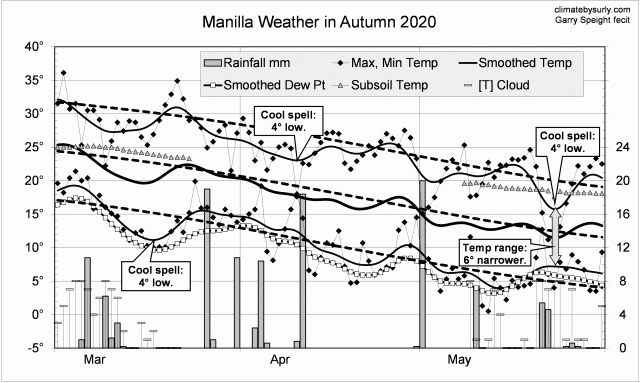New data for monthly rainfall totals at Manilla up to August 2020 show an altered pattern since October 2019 in this worst-ever drought.
[For explanation of this graph, see below: “About drought duration graphs”.]
Shortages January 2000 to August 2020
At Manilla, acute seasonal droughts ceased in 2019
Two periods of extreme rainfall shortage had extended through the mid-winters of 2018 and 2019. These were acute shortages of seasonal to annual duration. However, by the end of 2019 these very short-term rainfall shortages had ended: they were no longer extreme shortages in the 1st percentile. Although they were not even serious shortages, the fact that monthly rainfalls were below average prevented district water storage levels from rising.
As the 15-month, 18-month, and 24-month shortages persisted beyond January they ceased being extreme (1st percentile), but became merely severe (5th percentile). By that time, these two to three-year rainfall shortages had lasted longer as extreme (1st percentile) shortages than ever before (such as in 1965 or 1912).
Continuing extreme rainfall shortages
Extreme rainfall shortages linked to the 2018-19 drought at Manilla are now concentrated in the mid-range of duration – about 3-years to 10-years.
From 30-month duration up to 240-months duration, nearly all the selected durations are coloured red for extreme rainfall shortage, persisting up to the current month (August 2020). In this super-drought, extreme shortages of longer duration consistently had onset earlier than those of shorter duration: the longest, that of 240-month duration, started before 2000. (At Manilla, historic droughts differ in their pattern of date of onset versus date of drought-breaking.)
Not all very long-duration shortages are currently extreme.
At 108-month duration, the severity ceased to be extreme in March 2020. Neither the 120-month duration nor the 150-month duration reached beyond a severe shortage at any time. At the longest duration on the chart (360-months), not even a serious shortage has yet appeared.
Compete record to October 2019
For context, I have re-posted the graph for the whole historic record to October 2019.
About drought duration graphs
These graphs show the onset, persistence, and breaking of episodes of extreme and severe rainfall shortage (droughts) at Manilla. The Continue reading







